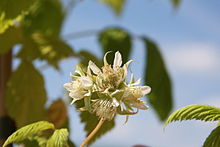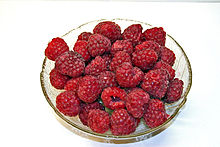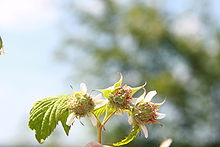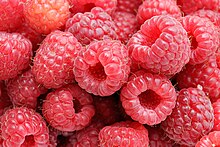raspberry
| raspberry | ||||||||||||
|---|---|---|---|---|---|---|---|---|---|---|---|---|

Raspberry ( Rubus idaeus ), illustration |
||||||||||||
| Systematics | ||||||||||||
|
||||||||||||
| Scientific name | ||||||||||||
| Rubus idaeus | ||||||||||||
| L. |
The raspberry ( Rubus idaeus ) is a species of the subgenus Idaeobatus in the genus Rubus within the family of Rosaceae (Rosaceae). The diverse uses of the plant by humans are reflected in numerous regional folk names.
description
The raspberry bush reaches a height of 0.6 to 2 meters. The rods are covered with fine spines . The alternate leaves arranged on the stem axes are petiolate. The imparipinnate leaf blades consist of three, five or seven toothed leaflets.
Between May and August, paniculate inflorescences are formed from the individual shoot axes . The hermaphroditic flowers are radial symmetry and five-fold with a double flower envelope . The flower base is strongly protruding. There are five sepals . The five free petals are white. The more than twenty stamens are free and fertile . There are free carpels .
The fruits that are red when ripe, and yellow or black when cultivated, are, contrary to what the common name raspberry suggests , botanically speaking not berries , but aggregate drupes that are formed from the individual carpels. In contrast to the blackberry , the fruit is only loosely attached to the flower base and can be easily pulled off. Depending on the variety, raspberries can be harvested from June until the first frosts in late autumn. Their main odor component is the raspberry ketone .
The number of chromosomes is 2n = 14.
ecology
The raspberry is a deciduous pseudo-shrub. The upright shoot axes are newly formed every year from the wintering rhizome . They bloom and fruit in the second year (rarely in the first year of some cultivars) and die after the fruit ripens . In contrast to blackberries , the shoots do not take root at the tip. The thin, soft spines are not used for climbing.
The flowers are homogamous "bluebells with sticky pollen". The odorless flowers offer plenty of pollen and nectar ; they are therefore often visited by bees of all kinds (bee pasture) and butterflies. The nectar has 46% sugar. Flowering time is from May to August. Normal sexual reproduction takes place.
In addition, vegetative reproduction is possible through underground creeping shoots (root shoots). This makes the raspberry a typical clear-cut plant that can also spread very invasively in gardens and thus become a "weed".
In contrast to other types of the genus Rubus, the collective drupes easily detach from the flower base. Digestive dissemination by larger and smaller mammals and birds is possible. As a garden plant, the raspberry is also spread by humans. Fruit ripening is from June to September.
Like sloe and blackberry, the raspberry is home to 54 species of caterpillars .

Occurrence

The wild raspberry is widespread in temperate to boreal Europe and western Siberia . In the Mediterranean zone, it becomes increasingly rare towards the south and is tied to the montane to subalpine areas of the mountains. In the Alps it rises to an altitude of around 2000 meters, for example in the Allgäu Alps on the Walmendinger Horn up to 1930 meters. There are naturalized occurrences in eastern North America, in Greenland and in New Zealand .
The raspberry appears as a forest pioneer on bare land . It prefers kali - and nitrate rich soils in sunny to partially shaded locations, for example on forest clearings and forest edges with high humidity and cool summer temperatures. Raspberries do not tolerate waterlogging because they are sensitive to root diseases.
In terms of plant sociology, the raspberry is a character species of the Rubetum idaei from the Sambuco-Salicion association in Central Europe.
Systematics
Raspberries belong systematically to the subgenus Idaeobatus (Focke) Focke . Related species occur in eastern North Asia ( Rubus nipponicus ) and in North America ( Rubus strigosus , Rubus melanolasius ).
Origin of name
The scientific name Rubus idaeus , first published by Carl von Linné in 1753, can be traced back to the De materia medica (written around 50 to 68 AD) by Dioscurides , but probably goes back to the Greek doctor Krateuas (around 100 BC). ) back. Pliny the Elder mentions the name in his work Naturalis historia (approx. 77 AD) in two places and writes that the Greeks called the plant "Idaeus rubus" because it would only grow in Ida. The nature of the likely Ida Mountains in Troas named because only these mountains in the circulation area of raspberry is, while the way in a wide radius of as "Ida" called Psiloritis -Gebirges Crete missing.
The German name of the raspberry (derived from the Old High German name Hintperi ) is derived from the Old Norse and Anglo-Saxon word hind (deer), which means berry of the hind .
For the term raspberry there were and are various names in the vernacular. The word raspberry was often modified in such a way that the resulting forms are based on terms such as honey, bumblebee or Imme. The consonant H of the raspberry was also often omitted. Examples are Imbere (Eifel), Imper (Tyrol, Alsace), Himmere (Göttingen), Humbel (Bergisch), Raspberry Berry (Silesia), Hindlbeer (Upper Austria), Hummelbeer (Vorarlberg), Holbeer (Bavarian-Austrian, Swabian). The Swiss names Haarbeeri and Sidebeeri refer to the silky hair on the underside of the leaves and the fruits. The Swiss Association for Vegetarianism still uses the term hollow berry as a synonym on its homepage. This is also an older German name, as well as catberry, grudge berry, witch's blackberry, mollberry or ambas etc.
use
history
The raspberry has been known as a medicinal plant since ancient times . The content of vitamin C, potassium and fruit acids is said to promote the immune system and wound healing. In the Middle Ages it was mainly cultivated in monasteries. As early as 1601, Clusius distinguished between red and yellow species.
sorts
A basic distinction is made between two types of raspberry: summer raspberries and autumn raspberries (remontant varieties). Remounting varieties bear fruit several times a year. Mostly - for operational reasons - all shoots of autumn raspberries are cut off after the harvest, which leads to new shoots in the following year and a one-off harvest in autumn. In the case of summer raspberries, the new shoots are left and a harvest is brought about at the end of June / beginning of August. Important raspberry varieties are:
- Tulameen: very aromatic variety, large, tapering towards the bottom, problems with the formation of new shoots, prone to Phytophthora
- Glen Ample: early, great
- Himbotop: autumn raspberry , Swiss cultivation, large, firm fruits, very strong growing
- Autumn Bliss: autumn raspberry, ripening in early August, aromatic, resistant to root diseases
- Polka: autumn raspberry, aromatic, large, ripe in mid-August
- Schönemann: late-ripening German variety with elongated, firm, somewhat sour fruits
- Zefa: autumn harvest, firm fruits
- Lloyd George , old variety, dark red fruits
Cultivation
Since the seeds of the raspberry do not germinate within a set period, accelerated germination is used in horticulture .
Single-bearing raspberries (summer raspberries) are usually pulled along a wire frame. Around ten fruit rods per meter are left and tied to the wire. During and after the fruit ripens, new rods grow from the roots. Summer raspberry crops are pruned immediately after harvest. The removed rods are cut off at ground level and the new shoots tied up. Remounting raspberries (autumn raspberries) are cut off at ground level after the harvest (November). New fruit canes form in spring, which in turn produce fruit in autumn. If the removed rods are left over the winter, a small early yield (June) is also possible. However, this should be canceled three weeks after the start of the harvest in order not to endanger the late yield. Raspberries require an even supply of nutrients with sufficient water supply. It is recommended to cover the row of plants with mulch material such as straw or bark compost. In 2011, 4778.4 tonnes of raspberries were harvested on farms across Germany on an area of 1118 hectares. This corresponds to a yield of 4.27 tons per hectare.
World production
In 2018 the world harvest was 870,208 tons. The country with the largest raspberry production in the world was Russia, which produced 19.1% of the world's harvest. Europe was responsible for around 68.2% of the world's harvest.
The ten largest raspberry producers in 2018 were:
| Country of production | Amount in t |
|---|---|
|
|
165,800 |
|
|
130.187 |
|
|
127.010 |
|
|
115,613 |
|
|
99,250 |
|
|
43,705 |
|
|
35,150 |
|
|
27,466 |
|
|
19,681 |
|
|
18,229 |
Diseases and pests
The most important disease in raspberries is Phytophthora (red root rot), which leads to reduced growth of new shoots and, in the long term, to death of the cane. Another important disease is rod disease, which can be traced back to several pathogens. While Phytophthora can only be prevented by an optimal soil structure, the rod disease can be combated with fungicides. Pests on the raspberry are aphids , raspberry flies , raspberry gall flies, raspberry beetles and spider mites . Viral diseases that can cause dwarfism or produce dwarf crops are another risk in commercial cultivation.
use
Stone core finds in pile dwellings from the Neolithic show that raspberries have been important fruit plants since the Stone Age . They were not cultivated until the 16th century. The plant is a popular garden plant for its fruits. The fruits, which are extremely healthy due to their high vitamin content, are often consumed raw or used in a variety of ways in the kitchen , for example as jam , jelly , compote , juice , cake topping, cold bowl or fruit groats . In 2011, 82.9% of the agriculturally harvested fruits were used as dessert fruits, 7.8% as industrial or processing fruits. 9.2% were not marketed. In beekeeping , raspberries are a valued sideline due to the high sugar content (36–70%) of their nectar and its high sugar value (0.18–3.80 mg sugar / day per flower) . The berry fruit is also used to flavor pure alcohol. The resulting spirit is called raspberry spirit . The berries do not ripen after harvest. They are therefore one of the non-climacteric fruits .
Nutritional value / ingredients
Because of their low sugar content, raspberries are particularly low in calories.
| Vitamins per 100 grams | |||||||
| Vitamin B1 | Vitamin B2 | Vitamin B6 | vitamin C | Vitamin E. | |||
| 0.02 mg | 0.05 mg | 0.08 mg | 25 mg | 0.91 mg | |||
| Minerals per 100 grams | |||||||
| zinc | iron | potassium | Calcium | magnesium | sodium | ||
| 0.4 mg | 1 mg | 170 mg | 40 mg | 30 mg | 1.3 mg | ||
Example: 100 grams of raspberries contain 1300 mg of citric acid, 190 mg of potassium, 40 mg of malic acid and 25 mg of vitamin C.
Use as a medicinal plant
Medicinal drugs are the dried raspberry leaves, Rubi idaei folium (DAC) and raspberry syrup prepared from the fresh fruits - Rubi idaei sirupus. The active ingredients are tannins ( gallotannins and ellagitannins ), flavonoids and vitamin C in the leaves , and minerals , vitamins , fruit acids , coloring glycosides and flavorings from around 100 components in the fruit .
The leaves are used in folk medicine like the leaves of blackberries , because of their tannin content as a tea for mild diarrheal diseases, to gargle for inflammation in the mouth and throat, and more rarely for washing with chronic skin diseases. Fermented raspberry leaves can be reminiscent of the taste of black tea , so they are often found in home tea blends. The syrup is used to improve the taste and color of medicines, since ancient times it has been given (diluted) as a thirst-quenching drink for people with a fever.
In naturopathy , fruits, leaves, flowers and roots are used. For example, the berries are cooked or eaten raw, or the various parts of the plant are used as teas, tinctures or baths.
The plant's effects range from anti-inflammatory, blood-purifying, astringent to calming, antipyretic, diuretic and sweaty. It is used, among other things, for a weakened immune system, rheumatism, sore throat, mouth ulcers or digestive problems.
Raspberry leaf tea can have a cycle- regulating effect and reduce menstrual cramps and an existing premenstrual syndrome (PMS).
As an old home remedy , raspberry leaf tea is used to prepare for birth . Among other things, it should induce labor and serve to widen the cervix and cervix . However, the effect has not been scientifically proven and little research has been done on side effects.
swell
literature
- Peter Schütt , Hans Joachim Schuck, Bernd Stimm (eds.): Lexicon of tree and shrub species. The standard work of forest botany. Morphology, pathology, ecology and systematics of important tree and shrub species . Nikol, Hamburg 2002, ISBN 3-933203-53-8 (reprint from 1992).
- Helmut Genaust: Etymological dictionary of botanical plant names. 3rd, completely revised and expanded edition. Nikol, Hamburg 2005, ISBN 3-937872-16-7 (reprint from 1996).
- W. Scherer: Recognize damage to raspberries and blackberries, determine - act correctly . Scherer, Augsburg 1989
Individual evidence
- ↑ Eckehart J. Jäger (Ed.): Exkursionsflora von Deutschland. Vascular plants: baseline . Founded by Werner Rothmaler. 20th, revised and expanded edition. Spektrum Akademischer Verlag, Heidelberg 2011, ISBN 978-3-8274-1606-3 , p. 424-425 .
- ↑ a b Erich Oberdorfer : Plant-sociological excursion flora for Germany and neighboring areas . 8th edition. Stuttgart, Verlag Eugen Ulmer, 2001. Page 511. ISBN 3-8001-3131-5
- ↑ a b c d Ruprecht Düll , Herfried Kutzelnigg : Pocket dictionary of plants in Germany and neighboring countries. The most common Central European species in portrait . 7th, corrected and enlarged edition. Quelle & Meyer, Wiebelsheim 2011, ISBN 978-3-494-01424-1 , p. 675-676 .
- ↑ Helmut Hintermeier: The privet and its guests. In: General German beekeeping newspaper . November 2008, pp. 30, 31
- ↑ Erhard Dörr, Wolfgang Lippert : Flora of the Allgäu and its surroundings. Volume 2, IHW, Eching 2004, ISBN 3-930167-61-1 , pp. 41-42.
- ↑ John Seymour: The New Book of Life in the Country. Extended edition . Dorling Kindersley, Munich 2010, ISBN 978-3-8310-1577-1
- ↑ a b Helmut Weiß, Christian Gosch, Andreas Fischerauer: Beerenobst. Varieties, planting, care, processing . Stocker, Graz 2001, ISBN 3-7020-0906-X
- ^ A b c Heinrich E. Weber: Rubus. In Heinrich Egon Weber (Ed.): Illustrated flora of Central Europe . Founded by Gustav Hegi. 3rd, completely revised and enlarged edition. Volume IV. Part 2A: Spermatophyta: Angiospermae: Dicotyledones 2 (2) (Hamamelidaceae - Rosaceae 1st part) . Blackwell, Berlin a. a. 1995, ISBN 3-8263-3016-1 , pp. 309-315 .
- ↑ Carl von Linné: Species Plantarum. Volume 1, Lars Salvius, Stockholm 1753, p. 492 ( digitized version )
- ^ Dioscurides: De materia medica , translated passage
- ^ KE Hummer, J. Janick: Rubus Iconography: Antiquity to the Renaissance . In: Acta Horticulturae. Volume 759, 2007, pp. 89–106 (PDF file; 1.65 MB)
- ↑ Pliny: Naturalis Historia , passage 1
- ↑ Pliny: Naturalis Historia , passage 2
- ↑ a b Konrad Keipert: Soft fruit. Cultivated species and wild fruits . Eugen Ulmer, Stuttgart 1981, ISBN 3-8001-5517-6
- ↑ Gourmet trip: Bon appetit , overview by Gisela Schmidt on vegetarismus.ch.
- ↑ Revista de Medicina, Lenguaje y Traducción. Vol. XII, No. 34, 2nd semester, Panace @ 2011, p. 191, online ( memento of the original dated August 1, 2018 in the Internet Archive ) Info: The archive link was inserted automatically and has not yet been checked. Please check the original and archive link according to the instructions and then remove this notice. on docplayer.es, accessed on August 1, 2018.
- ↑ Reto Neuweiler: Berries and special types of fruit . Agricultural teaching material center, Zollikofen 2000, ISBN 3-906679-75-6
- ↑ Thomas Rühmer: Fruit varieties: practical portraits of market-relevant varieties . Österreichischer Agrarverlag, Vienna 2006, ISBN 3-7040-2162-8
- ↑ Georg W. Kröger (ed.), Gustav Engel u. a .: BdB manual part VI, fruit trees . Support company "Green is Life" Baumschulen, Pinneberg 1985
- ↑ Growth and Harvest - Fruit - Issue 14 (annual issue). (PDF file; 0.2 MB) (No longer available online.) In: Fachserie 3 Reihe 3.2.1 - 14/2011. Federal Statistical Office, January 10, 2012, p. 13 , archived from the original on November 15, 2012 ; Retrieved October 23, 2012 . Info: The archive link was inserted automatically and has not yet been checked. Please check the original and archive link according to the instructions and then remove this notice.
- ↑ a b Crops> Raspberries. In: Official FAO production statistics for 2018. fao.org, accessed on April 22, 2020 .
- ↑ G. Baumann: Elimination of a heat-stabel raspberry virus by combining heat treatment an meristem culture . In Acta Horticulturae , Volume 129, 1982, pp. 11-12 (abstract)
- ↑ Ulrich Hecker: Deciduous trees Wildly growing trees, shrubs and dwarf trees. BLV Verlagsgesellschaft, Munich 1985, p. 147
- ↑ a b Bundessortenamt (Ed.): Descriptive list of varieties raspberry, blackberry . Deutscher Landwirtschaftsverlag, 2006, ISSN 1610-5184 , p. 9 ( PDF file; 4.4 MB [accessed October 23, 2012]).
- ↑ Growth and Harvest - Fruit - Issue 14 (annual issue). (PDF file; 0.2 MB) (No longer available online.) In: Fachserie 3 Reihe 3.2.1 - 14/2011. Federal Statistical Office, January 10, 2012, p. 20 , archived from the original on November 15, 2012 ; Retrieved October 23, 2012 . Info: The archive link was inserted automatically and has not yet been checked. Please check the original and archive link according to the instructions and then remove this notice.
- ↑ Helmut Horn, Cord Lüllmann: The great honey book . 3. Edition. Kosmos, Stuttgart 2006, ISBN 3-440-10838-4 , p. 30
- ↑ The ten low-sugar fruits , menshealth.de
- ↑ a b c raspberry , fid-gesundheitswissen.de
- ↑ a b EU nutrition labeling directive (EU NWKRL 90/496 / EEC) and Rewe nutrition table
- ↑ Hecker, Ulrich: Deciduous trees Wild growing trees, shrubs and dwarf trees, BLV Verlagsgesellschaft, Munich, 1985, p. 147
- ↑ a b Ingrid Schönfelder, Peter Schönfelder : The new manual of medicinal plants, botany medicinal drugs, active ingredients, applications . Franckh-Kosmos, Stuttgart 2011, ISBN 978-3-440-12932-6 , pp. 388-389
- ↑ Raspberry , heilpflanze-wissen.de
- ↑ Tips from the midwife , rund-ums-baby.de
- ↑ Medicinal plants for pregnancy , Frauen-heilkraeuter.de
- ↑ Raspberry Tea, tee-magazin.de
- ↑ Raspberry leaf tea makes childbirth easier , netmoms.de
- ↑ Lone Holst, Svein Haavik, Hedvig Nordeng: Raspberry leaf - should it be recommended to pregnant women? In: Complementary therapies in Clinical Practice . Volume 15, No. 4, pp. 204-208, DOI: 10.1016 / j.ctcp.2009.05.003 , PMID 19880082
Web links
- Raspberry. In: FloraWeb.de.
- Profile and distribution map for Bavaria . In: Botanical Information Hub of Bavaria .
- Rubus idaeus L. In: Info Flora , the national data and information center for Swiss flora .
- Distribution of the raspberry (including related clans) in the northern hemisphere from: Eric Hultén, Magnus Fries: Atlas of North European vascular plants. 1986, ISBN 3-87429-263-0 at Den virtuella floran. (swed.)
- Thomas Meyer: Data sheet with identification key and photos at Flora-de: Flora von Deutschland (old name of the website: Flowers in Swabia )
- Pick berries and fruits yourself on Swiss farms











